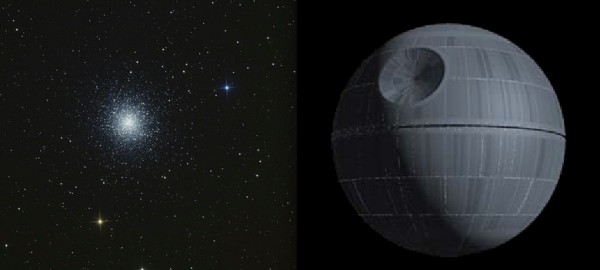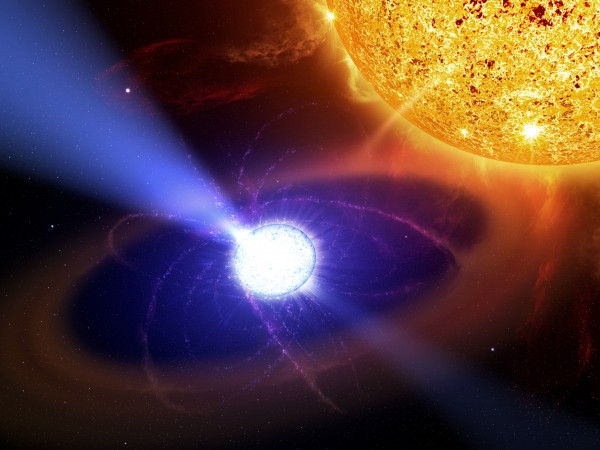"From the intrinsic evidence of his creation, the Great Architect of the Universe now begins to appear as a pure mathematician." -Sir James Jeans
Last time we met, I posed a mystery to you: why are globular clusters the smallest in the Universe?

And what's more than that, we never find them in isolation! We always find them bound to galaxies (or, if not bound to a galaxy, then within a cluster of galaxies; thanks Steinn), but never just off in deep space, floating on their own like some lone Death Star.

Like all structures in the Universe, everything we're talking about here -- stars, globular clusters, galaxies, and clusters -- formed from gravitational collapse. But all things don't collapse equally! Something resists gravitational collapse, and regardless of what causes it, it's always some type of pressure.

The Sun, for instance, is less dense than the Earth is, despite being 300,000 times as massive! What's going on here? The tremendous pressure generated from the Sun burning its nuclear fuel actually pushes the outer layers of the Sun away from the center, balancing the force of gravity and preventing it from collapsing any farther.

In that case, you get a super-dense, collapsed star, like a white dwarf star. (To the left of the Sun-like star, above.) Without the pressure from nuclear fusion, it's a lot denser, and its collapses even farther. Except it can't collapse forever, because there's a new source of pressure: the atoms themselves!

What does this have to do with globular clusters? Let's go all the way back to when the Universe was filled with photons, nuclei and electrons, but before we formed neutral atoms!

Gravity is working as hard as it can to collapse everything down to smaller, denser structures. And it's most successful where there's the most amount of matter. But when the Universe is this young, the pressure from the photons flying around is simply too much! Whenever gravity gets the upper hand and a cloud of matter starts to collapse, the photons push back even harder, and the cloud gets washed out!

So all the tiny little structures that try to get formed -- things that would be the size of isolated planets, stars, and open star clusters -- get washed out. Until, that is, you form neutral atoms for the first time! That's at the same time that the Cosmic Microwave Background (CMB) gets emitted. The CMB is this famous guy, for those of you who like pictures.

But now, with neutral atoms, they interact with photons way less frequently than they did when all the matter was ionized. What does this mean? It means the pressure drops tremendously, and all of these structures can now collapse!

But the small structures -- the ones that would be small structures, anyway -- have all been washed out! If you want to know what the smallest structure on its own you can form is, you have to look to the work of James Jeans, and hence the quote at the top. If you plug in the numbers for the density and temperature of the Universe at this time into the Jeans' Length equation to find the mass of the smallest structure that you get, you know what you find?
The smallest structures you form are between 100,000 and 1,000,000 times the Mass of the Sun! So that's why you never get a cluster, on its own, that's smaller than a hundred thousand stars!
And why are they never on their own?

Quite simply, because gravity works like a web, and pulls small structures together into larger ones. By this point, nearly 14 billion years after these seeds for structure formation were sown, gravity has had enough time to pull all of these clusters into larger structures! (Err... probably. We have to remember that absence of evidence does not mean evidence of absence.)
And that's why Globular Clusters are the smallest! Happy Monday!

OK, fine, but why don't they collapse?
At a guess, I'd say it's because their stars are still shining, and that radiation is enough to push back against gravity's paltry level of attraction.
They'd have to lose too much angular momentum to do so. There isn't much scope to lose that momentum.
Of course the question would always be, so why'd they collapse that far, but not farther? That I certainly don't know, possibly something to do with gas (and magnetic fields that could transfer angular momentum outward within the gas) that dissipated before they collapsed too far. But as much angular momentum as they lost to become globular clusters, much more would have to be lost in order to collapse into each other.
Or in other words, they're orbiting a common "center of mass", and nothing exists to prevent them from continuing to do so.
I have to add one more caveat. Actually, there are forces (gravitational interactions, primarily, I believe, which "evaporate" the cluster drawing away angular momentum) tending to make globular clusters collapse, and it is thought by some that binary stars falling into lower orbits around each other liberate kinetic energy that delays (for a very long time) this collapse. But it's the orbital energy alone that keeps the stars apart at any one time.
Glen Davidson
OK, The question in my mind is how do the galactic and intergalactic clusters differ?
We observe a great many more associated with galaxies.
Tho both are destined to follow the Jeans instability/ length formula, they do reside in a differing environment... or do they? This, in my opinion has to have some effect on some aspect of their existence.
If all they needed was the James length to fire up and maintain then I suspect we would see a great many of them all over the place, if the gasses puddle or acreate over time.
I suppose we could just be at a specific time in evolution where the majority of GC,s are bound up into galaxies.
Yet,but for this nagging in my mind telling me that a specific environment must be a precursor to slightly trigger the hydrostatic equilibrium to ignite the gasses.
This leads me back to what you said about the Lagrangian points. Points that are gravitationally offset by two or more bodies.
Perhaps it is the stability of the environments (the halo and maybe Lagrangian) that allows the Clusters to concentrate and exist.
Tho the article by Dr. West speculates GC,s ripped from their home galaxy, I find it plausible for the precursor gas to be ripped away easier.
I envision rotating gas clouds, invisible to all but the most sensitive instruments, losing rotation upon ignition.
Therefore the wandering gas puddles collect where they can and ignite as you describe above.
Just a thought.
Hey Glen Davidson, I see you posted above, and since you're really in tune to the workings of the brain, I thought I would pitch a bit of woo and make a connection between the picture that Ethan posted last, of the gravity web and the artist rendition of the human brain Neural network...so, just pattern recognition or what.
Kinda eerie if you ask me... but then why wouldn't we be similar in design, since we are made of the same matter.
Been thinking about that for some time now, ok back to galaxy clusters, The article referred to by Ethan says
" With only one exception, all of the intergalactic globular clusters the teams have detected are so far away (millions of light-years) that they just look like tiny points of light in a vast sea of blackness."
I'm curious about the one exception, any more info on that one? Steinn Sigurðsson?
Last I heard, simulations of these things really did collapse in a very short time. Has some mechanism been discovered that those simulations failed to model? A plug of dark matter with the cluster in the middle would slow things down some, but not otherwise change much.
Oh, I doubt that it's just pattern recognition. There are similarities in growth, since brain cells grow toward each other along chemical gradients. It's true that the galactic webs grow differently (essentially maintaining continuity, rather than creating it), but centers connected by "strings" are going to end up looking at least somewhat similar.
But of course most neurons are arranged more hierarchically and zonally, apparently in order to do at least somewhat different types of things in the various zones ("top" down generally), then to collect information into fewer neurons to feed into the lower layers. I think the universe's web looks more like the internet than like most brain cell arrangements, although neurons connecting various regions might get closer to the internet or to the universe's arrangment -- interneurons by themselves look something like the picture shown, IMO.
Or maybe it has more to do with inhabiting the same spacetime, thus "organic growths" of matter connections will have similarities to each other.
Yes, good question, which I hope will be answered.
Glen Davidson
http://tinyurl.com/mxaa3p
The micro and macro universe(s) stack up in the same way for the same reasons? That might be a stretch if you'll pardon the pun albeit a seemingly all too reasonable one. Talk about the human mind's tendency to recognize and group patterns... as earlier commented upon mentioning the brain's neural net image - it too are one.
It would help to bear in mind that what we see is also but a snapshot of ongoing processes to be considered in the long run. The balancing act of forces that make up even our own sun as reported herein might be kind of scary if you think about it for too long. Awesome pictures as usual, thanks.
A few questions about globular clusters.
Do they account for any of the dark matter? e.g. They seem to be composed of very old stars: are any globular clusters composed of primarily dark (dead)stars?
Has anyone estimated the number of globular clusters per various types of galaxies?
Do globular clusters have black holes at their centers? Why? or why not?
I assume that the globular clusters of very distant galaxies are very hard to see; but how does the age of a galaxy relate to the number of globular clusters surrounding it? Any theories?
Since globular clusters are mostly composed of very old stars; are there any theories that somehow globular clusters are remnants of old galaxies?
Are there any freak globular clusters that are composed primarily of young stars? Why? or why not?
Thanks for any theories, best guesses, or rough insights.
this is good stuff